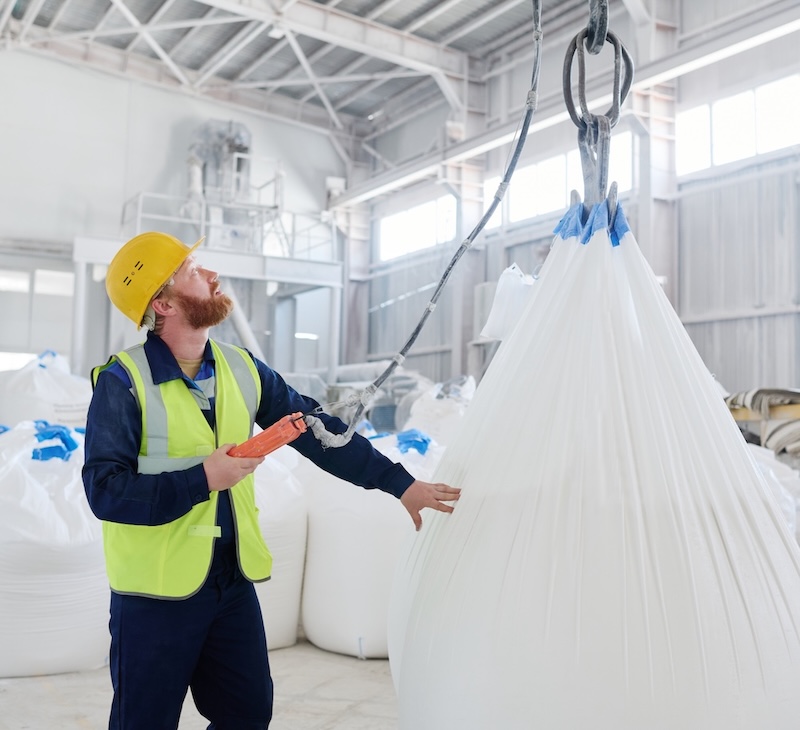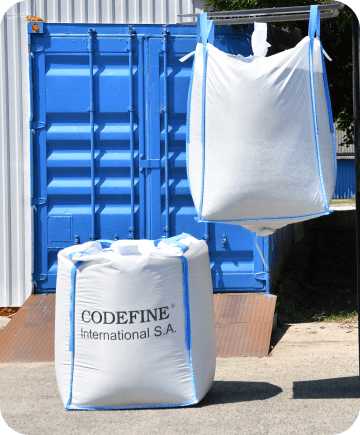Home » Posts Page » Blog » Codefine » Life Cycle Assessment (LCA) of FIBC Bags: What Buyers Should Know

Life Cycle Assessment works as an environmental audit, tracking each stage of a product’s life. For flexible intermediate bulk containers (FIBCs), this journey starts with extracting raw materials and continues through production, shipping, use, and eventual disposal or recycling.
The process examines several environmental factors vital for companies with sustainability goals. Carbon emissions, energy use, water consumption, land effects, acid rain potential, and water pollution all come under review. LCA stands apart by enabling meaningful comparisons between packaging alternatives while identifying improvements for current solutions.
LCA goes far deeper than basic green metrics many companies promote. By spotting which specific lifecycle stages create the biggest environmental problems, you can focus improvement efforts where they’ll make genuine differences instead of spending money on cosmetic changes that look good on paper but barely help the planet.
Every bulk bag has an environmental story starting with extracting resources. Most FIBCs come from polypropylene made from crude oil or natural gas. These materials go through refining before chemical processes turn them into polymers. This first phase usually accounts for a major part of the bag’s total environmental footprint.
Next comes manufacturing, where machines transform polypropylene into threads, weave fabric, cut patterns, and stitch everything into finished bags. Different FIBC types need specific manufacturing approaches based on their purpose. Standard Type A bags, low static Type B, static dissipative Type C, and anti-static Type D versions each have unique production needs. Shape matters too—circular designs, U-panel configurations, and baffle styles all require specialized techniques.
Transportation happens throughout the product’s life. Raw materials move to factories, finished bags ship to distributors, and finally reach your facility. Your choices about distances and transport methods greatly affect carbon output.
During use, FIBCs go through cycles of filling, storing, lifting, and emptying – sometimes repeatedly for multi-trip designs. Agricultural businesses using reusable bags have cut their environmental impact by spreading the production footprint across many uses.
At life’s end, bags face different fates. Some enter recycling streams to become new polypropylene products. Others find new purposes through creative reuse. Sadly, many still end up in landfills. Your local recycling options heavily influence the final environmental impact of your packaging choices.
Carbon footprint studies consistently show that creating materials and manufacturing bags generate the most greenhouse gases. A thorough LCA calculates emissions across the entire lifecycle, helping you pinpoint where changes would make the biggest difference.
Resource metrics reveal the raw materials, water, land, and energy each bag requires. Mining companies, food producers, and pharmaceutical manufacturers can gain real environmental advantages while managing costs by using resources more efficiently.
End-of-life scenarios play a crucial role. Polypropylene FIBCs potentially outperform some packaging alternatives because they can be recycled when proper systems exist. With good collection and processing, they become raw material for new products rather than waste sitting in landfills for centuries.
FIBCs typically perform well in comparative LCA studies. Their lightweight, toughness, and reuse potential give them advantages. One durable FIBC can replace dozens of smaller packages or several heavier containers, cutting both material use and shipping emissions substantially.
Reduced environmental footprint stands out when choosing LCA-optimized bags. Once manufacturers know which lifecycle stages cause the most harm, they can redesign products to lessen impacts while maintaining performance. Grain producers switching to bags with better UV protection have watched their packaging last three times longer in sunlight, dramatically cutting replacement needs.
Cost benefits emerge throughout the lifecycle despite sometimes higher upfront prices. Greener options often result in lower total costs through extended lifespan, reduced disposal expenses, and decreased shipping costs from lighter weight. Some agricultural operations paying 15% more for better-designed bags have reduced their total packaging expenses by nearly 30% over two years.
Staying ahead of regulatory compliance grows more valuable as environmental rules tighten worldwide. Companies already using LCA to guide packaging choices typically avoid last-minute compliance scrambles or penalties from non-conformance.
Brand reputation benefits too. Supply chain partners increasingly pressure businesses to reduce environmental impacts. Using LCA-optimized FIBCs lets you back sustainability claims with science instead of vague marketing talk. Customers notice this authenticity, building trust in ways generic “green” claims simply can’t match.
Start by clearly defining what your application needs. Different industries have different priorities. Chemical producers typically focus on safety and containment, while food companies worry about keeping products pure and protected. Establish your must-have requirements before considering environmental factors.
Looking beyond the price tag helps balance performance, cost, and environmental impact. Consider how long bags will last, whether you can reuse them, and what disposal options exist where you operate. Mining operations investing in premium, long-lasting Type D antistatic bags have found that despite almost double the initial cost compared to standard options, these bags handle harsh conditions through multiple uses, reducing both environmental impact and total cost over time.
Planning for changing regulations and market expectations represents smart business strategy. You might create a staged approach, making smaller improvements now while setting bigger goals for the future. This could mean gradually switching from single-use to multi-trip bags where practical, or working with suppliers to develop more recyclable designs as technology advances.
Codefine International SA integrates lifecycle thinking throughout product development. This Swiss packaging leader builds environmental considerations into every stage of designing and producing FIBC bulk bags, polypropylene bags, container liners, and jute products.
They’ve created options specifically engineered to minimize lifecycle impacts while meeting tough performance requirements across agricultural, chemical, construction, food, pharmaceutical, and mining industries. Their approach involves understanding customer-specific needs and identifying packaging solutions that balance operational demands with environmental performance.
For customers needing repeated use, Codefine offers exceptionally durable options built to withstand multiple trips. This spreads production impact across more uses. Their manufacturing processes include resource-saving measures that reduce waste and energy consumption.
Need reliable bulk bags you can count on? Codefine offers premium-grade options at competitive prices. Looking for additional packaging solutions? Browse our full product range online or connect with our team to discuss your specific needs.
